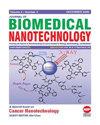The Value of Near-Infrared Multifunctional Nanoprobe Combined with Artificial Intelligence Microsensor Technology in Molecular Diagnosis for Gastric Cancer
IF 2.9
4区 医学
Q1 Medicine
引用次数: 0
Abstract
Since the symptoms of early gastric cancer patients are not obvious, the majority of new gastric cancer cases are progressive gastric cancer every year. In this paper, we applied nanomedicine technology to design and prepare multifunctional nanoparticles for the diagnosis and treatment of gastric cancer. Through targeted imaging of gastric cancer, combined with phototherapy and the prepared nanoprobes are applied to the ectopic transplantation tumor model of gastric cancer. Meanwhile, a fluorescent microsensor based on graphene oxide and deoxyribonuclease is constructed in order to realize the rapid detection of gastric cancer exosomes. The near-infrared multifunctional nanoprobe is combined with artificial intelligence microsensor technology and applied to the molecular diagnosis of gastric cancer. The results shows that the P-P-I-M+ laser irradiation group has the highest fluorescence intensity and its average fluorescence intensity is 2.04 times higher than that of the P-P-I+ laser irradiation group. The relative cell viability of P-P-M+ laser irradiation group, P-P-I+ laser irradiation group and P-P-I-M+ laser irradiation group are 62.5%, 41.9% and 19.3%, respectively. Therefore, the method in this paper can reduce the non-specific toxicity to other organs as well as exert the effect of combining the diagnosis and treatment of gastric cancer.近红外多功能纳米探针与人工智能微传感器技术在胃癌分子诊断中的应用价值
由于早期胃癌患者症状不明显,每年新增的胃癌病例以进展期胃癌居多。本文应用纳米医学技术设计制备了多功能纳米探针,用于胃癌的诊断和治疗。通过胃癌靶向成像,结合光疗,将制备的纳米探针应用于胃癌异位移植肿瘤模型。同时,构建了基于氧化石墨烯和脱氧核糖核酸酶的荧光微传感器,以实现对胃癌外泌体的快速检测。将近红外多功能纳米探针与人工智能微传感器技术相结合,应用于胃癌的分子诊断。结果表明,P-P-I-M+激光照射组的荧光强度最高,其平均荧光强度是P-P-I+激光照射组的2.04倍。P-P-M+激光照射组、P-P-I+激光照射组和P-P-I-M+激光照射组的相对细胞活力分别为62.5%、41.9%和19.3%。因此,本文的方法既能减少对其他器官的非特异性毒性,又能发挥胃癌诊断与治疗相结合的效果。
本文章由计算机程序翻译,如有差异,请以英文原文为准。
求助全文
约1分钟内获得全文
求助全文
来源期刊
CiteScore
4.30
自引率
17.20%
发文量
145
审稿时长
2.3 months
期刊介绍:
Information not localized
文献相关原料
| 公司名称 | 产品信息 | 采购帮参考价格 |
|---|

 求助内容:
求助内容: 应助结果提醒方式:
应助结果提醒方式:


